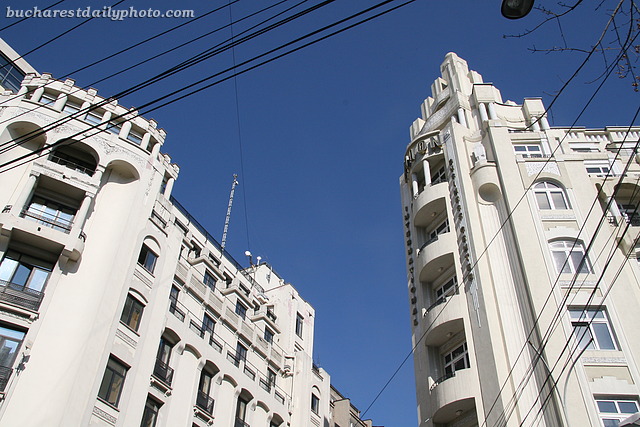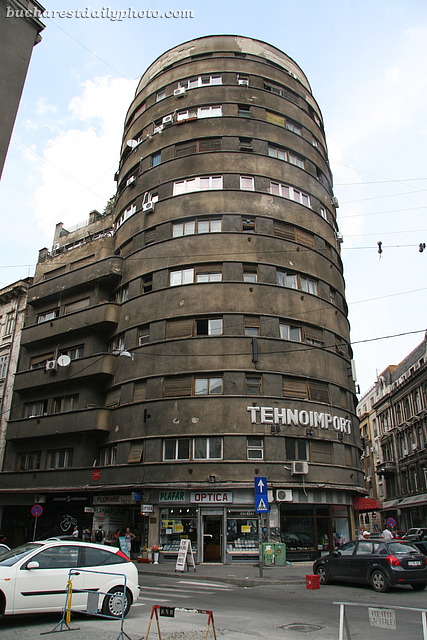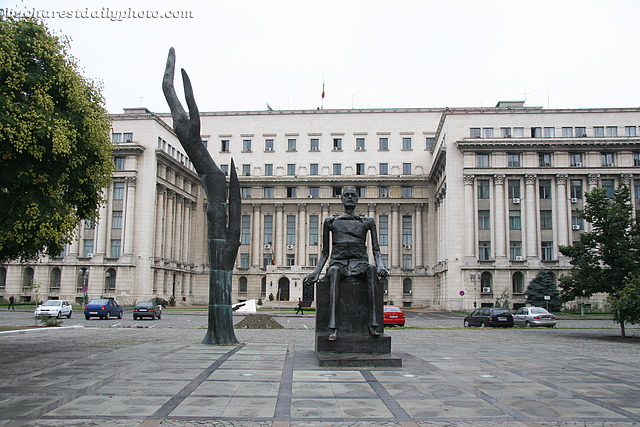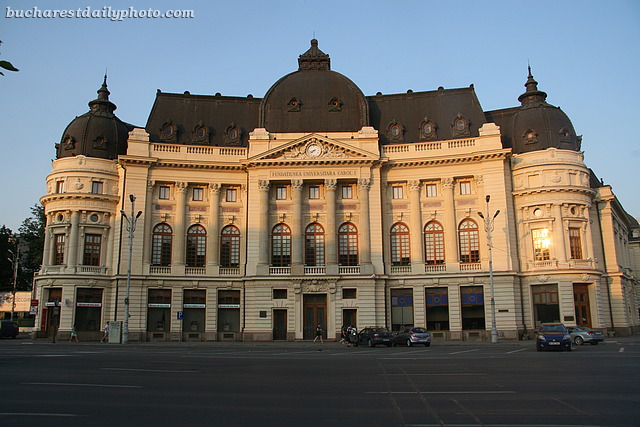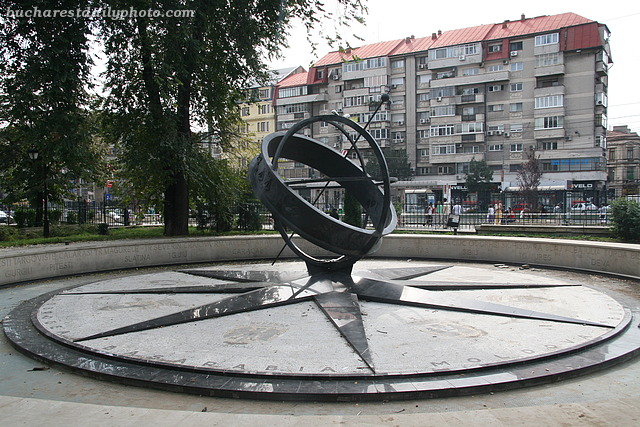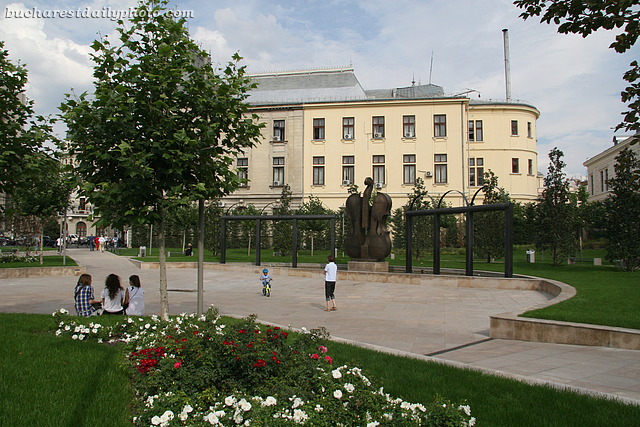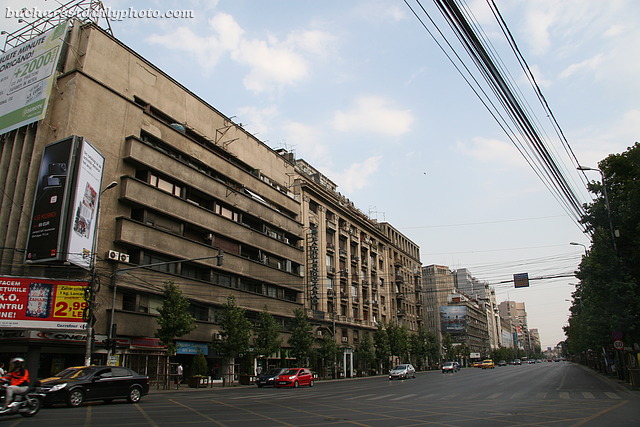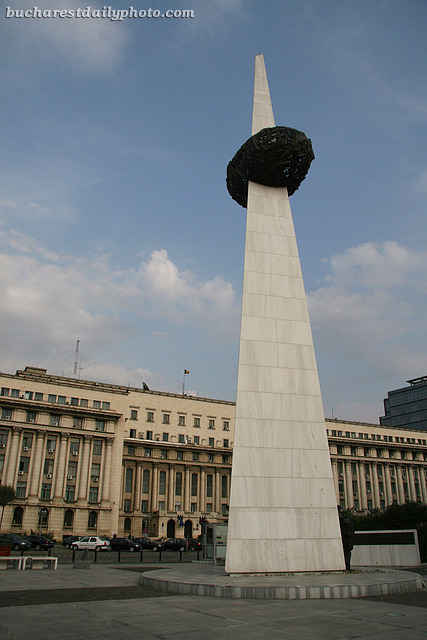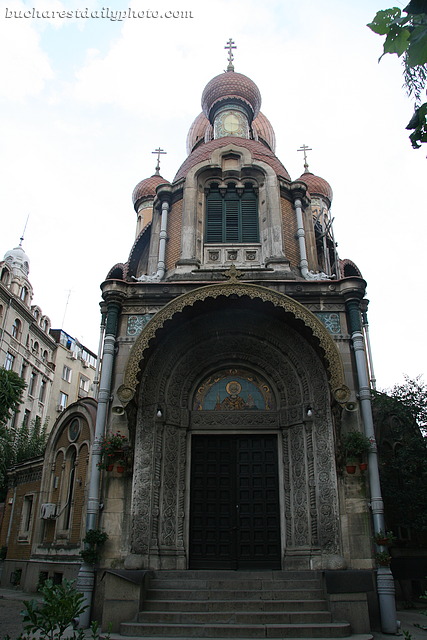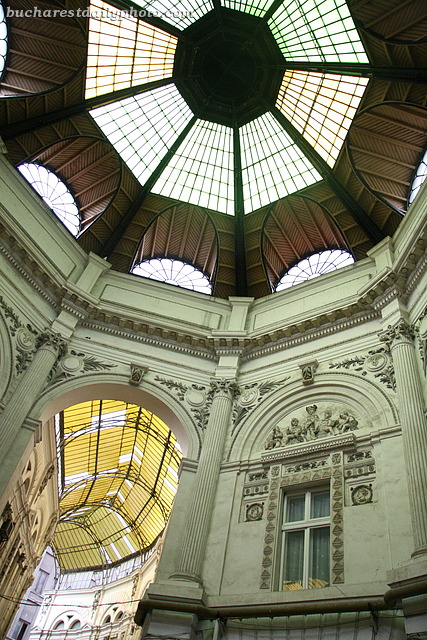I’ve already posted two examples (one and two) of Bucharest’s between the wars architecture. At that time the city was enjoying economic prosperity and new architectural ideas, like modernist and Art-Deco styles, were being promoted. Here are two more examples (in one photo) of Bucharest’s 1930s architecture; and this time the buildings have been renovated. To the left we have Hotel Stănescu (or Negoiu) and to the right Hotel Union. They were built in 1929-1931 after a design by architect Arghir Culina. They served as hotels until 1990 (if I’m not mistaken) and today they function as business centers. They are located at the intersection between Ion Câmpineanu Street and Academiei.
Many first-class modernist and Art-Deco buildings were erected in Bucharest between 1920 and the beginning of the WWII. Among them, this cylindrical tower on Doamnei Street designed by architect H. Stern in 1935. You don’t get to see many buildings like this one and that is why I like it despite its shabby look and dire need for renovation. Unfortunately the red dot at the base of the building tells us that the tower is most likely doomed. The red dot reads “This building has been appraised by technical expertise to fall within seismic risk class I”. I don’t know if you are aware but Romania (especially its southern part) lies in an earthquake area. The last big earthquake was in 1977. It had a magnitude of 7.2 and it killed around 1600 people and about 35.000 buildings were damaged.The buildings appraised as class I present a major risk of collapse in case of an earthquake of magnitude 7 of higher on Richter scale. Since more than 30 years have passed since the last big one, people are whispering that there’s time for the next one. Every year some fortune teller predicts the day the next big earthquake will take place and many people living in buildings like the one in today’s photo take to the streets for the day “just in case”.
Today is another crazy day when I’ll be traveling for 20 hours and I won’t have time for a lengthy post. But I didn’t want to miss the day so I decided to post a photo on a subject that I’ve already written about, just shot from another angle. This was one of my first posts so some of you might have missed it. Today’s subject is the Iuliu Maniu statue in Revolution Square and you’ll find the initial photo here.
In order to prolong the anniversary a little longer I decided that today I’ll post another postcard picture. This is the Central University Library (“Biblioteca Centrală Universitară” in Romanian), a beautifully ornate building located opposite the Royal Palace in the Revolution Square. The building was designed by the French architect Paul Gottereau who also designed the Royal Palace and the CEC Building (I have yet to post of picture of it). Construction was started in 1890 and the building was inaugurated in 1895 as the “Palace of Carol I University Foundation” being build on land bought by Carol I of Romania for the foundation that carried his name. In 1948 The Library of the University Foundation becomes The Central University Library, a state owned institution. The building was heavily damaged during the December 1989 Revolution when over 500000 books were lost in a fire. It was later restored and it opened again in 2001.
One thing I like about keeping this blog – aside from the good excuse to walk the city and take photos – is the documentation work that I do before I write about a subject. I get to find out many interesting things about the history of Bucharest, events I didn’t imagine happened. I started to read about the history of Bucharest a few years ago but every day I keep discovering new things; I guess that’s normal for a city of this size and with 550 years of history behind it. To give you an example, who would think that such a benign looking monument as is the one in today’s photo has an interesting story?
The monument in the photo marks Romania’s Kilometer Zero. For those not familiar with the concept, in many countries Kilometer Zero or Zero Milestone is a location (usually in the country’s capital) from which all road distances are measured. It is also customary that this spot is signaled by a marker or a monument. The Kilometer Zero of Romania is located in downtown Bucharest in front of New Saint George Church. And the story behind it is as follows. In the beginning of 1937 the city hall decided to erect a monument on this spot, marking Kilometer Zero. The “Military Stone” was supposed to be ready until May 9th 1937. In reality the monument was not finished by that date and its inauguration took place more than half a century later, in 1998. The monument was supposed to include a circular stone basin with a wind rose and in between the spokes of the rose were supposed to be mosaics with the names and the coats of arms of the Romanian provinces. In the center of the monument the artist imagined a sphere and on top of the sphere the statue of Saint George killing the dragon. After initially agreeing with the project the Romanian Church changed its mind and opposed the statue invoking the second commandment, which for the Orthodox church is “You shall not make for yourself an idol”. The sculptor, Constantin Baraschi, changed the project and instead of the statue of Saint George he proposed that the sphere carries the statue of – are you ready for this? 🙂 – Prince Charming killing the dragon. Still the project is rejected and before further changes were made the war started. After the end of the war the provinces of Bessarabia and Bukovina remained under Russian control and their coats of arms and names could not be admitted on the monument so the sphere was taken away and after 1950 the monument was covered with earth. The project was reinitiated only after 1990 when the basin and the wind rose were dug up. In the center of the monument there’s only a metallic zodiac sphere; nobody’s killing the dragon on top of it or anywhere close by. The monument was inaugurated on June 9th 1998, 61 years after its deadline. The historical provinces of Bessarabia and Bukovina do appear on the monument even though they are not part of Romania anymore. Also, among the cities inscribed on the stone basin are also Chişinău, Orhei, Tighina, which are currently in the Republic of Moldova, as well two towns now part of Bulgaria but which were part of Greater Romania from 1913 to 1940.
Wow, this was a loooong post. But I though the story was interesting and worth telling. I hope that in our ADD driven world someone will be patient enough to read it 🙂 – or rather someone will have the time to read it. I would also like to give credit to a fantastic book (unfortunately from what I know, available only in Romanian) in which I read most of the story told here. The name of the book is “Bucharest in dates and events” by Radu Olteanu.
Roughtly about two months ago I saw work being done on the southeast corner of the University Square, the one with Colţea Hospital and the Ministry of Agriculture building. Knowing that the little park was renovated only about two years ago I asked myself, as I’m sure many of my fellow citizens did, “Why are they renovating this corner again?”. Turns out they were repairing the fountain and installing a giant bronze violin, a work of artist Ioan Bolborea made after a project by the Italian artist Domenica Regazzoni. Domenica Regazzoni has a series of violins, the one installed in Univeristy Square being “The broken violin”. Sculpture aside, I really like this little corner of peace right in the heart of such a chaotic city as Bucharest. It’s a great place to sit on a bench and watch the world go by.
Seeing Magheru Boulevard on a weekend with only a few cars speeding by, it will be hard to be believe that this is the one of the busiest streets in Bucharest. Come Monday, the boulevard will be packed with cars barely inching along. Magheru Boulevard, named after General Gheorghe Magheru, a Romanian revolutionary, runs parallel to Victory Road (Calea Victoriei in Romanian) and even though Calea Victoriei is more imporant historically, nowadays Magheru is the commercial lider being one of the most expensive streets in Europe in terms of renting commercial spaces. For those interested in seeing between the wars architecture Magheru is the perfect place for a stroll, because most of the buildings that line the boulevard are from the 20s and 30s.
Nobody in Bucharest (besides its author) seems to like this monument which was added to the Revolution Square in 2005. Even though its official name is “The Rebirth Memorial Eternal Glory to the Romanian Revolution and Its Heroes from December 1989”, the citizens of Bucharest refer to it by various names including “potato on a stick” (the most common one) or “the donut/nut/meatball on a spike”, “the olive on a toothpick”, “the brain skewered on a spike” etc. Apparently its modern design has not appealed at all to the citizens of Bucharest. It is so controversial that last year some of the candidates for the seat of mayor of Bucharest declared that in case they will be elected they will move or demolish the monument.
If the onion dome architecture of the church in today’s photo makes you think of Russian Orthodox churches than you are on the right path. This is Bucharest’s Russian Church, or St. Nicholas Church after Emperor Nicholas II of Russia whose court provided the 600.000 gold rubles which were used for the construction of the building. The church was destined to be used by the employees of the Russian Embassy and by Russians living in Bucharest and service was initially held in Russian. The onion domes, which are not usual in Romania, were initially covered in gold. Construction lasted from the 1905 – 1909 under the guiding of the Russian architect V. A. Prevbrajenski. During WWI the church was closed and all valuables and the archive were transported to St. Petersburg where they were lost during the Russian Revolution. The church was transferred a couple of times from the authority of the Patriarchate of Moscow to the Romanian government and the Romanian Orthodox Church. The church is located downtown, close to the University of Bucharest and twice in its history it came under the patronage of the university (from 1934 to 1947 and again from 1992 to present time) for the use of the students and professors at the university. This is the reason the church is also known by a third name, “The Students’ Church”.
Since my photo from yesterday seems to have been a great success (the number of visitors was double compared to the day before) I decided to post one more picture from the Macca-Vilacrosse Passage. Today’s photo shows the glass roof at the base of the U-shape and a bit of the building that supports the roof.
